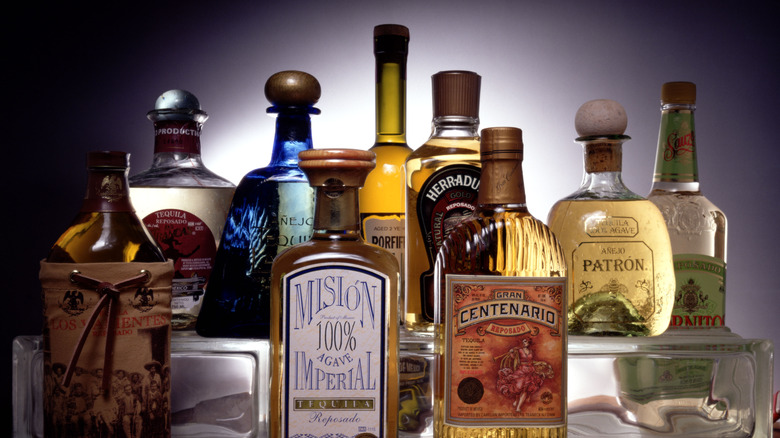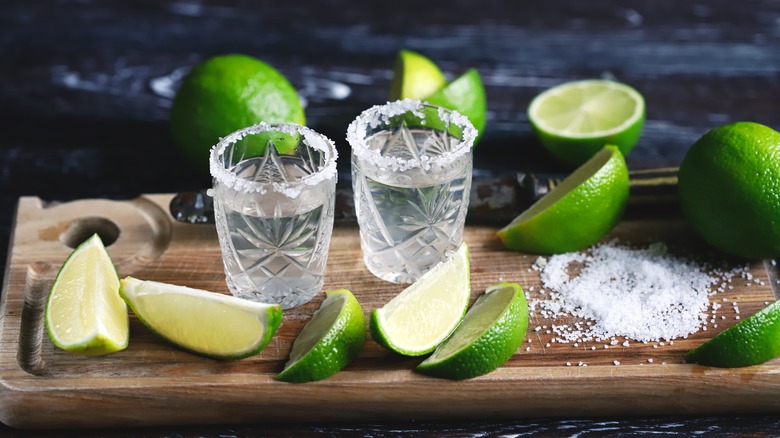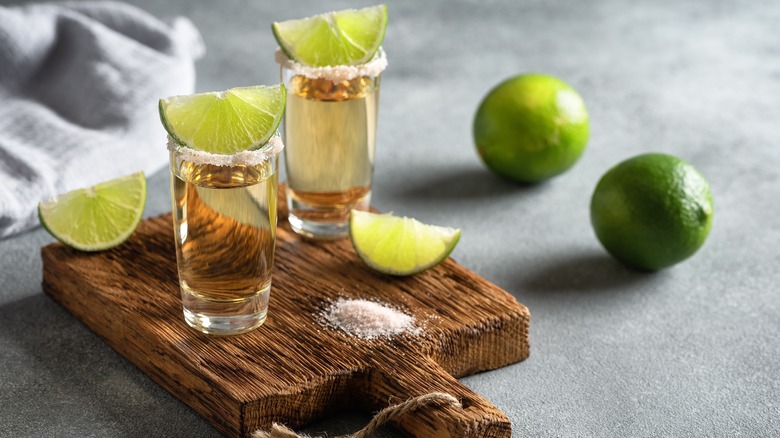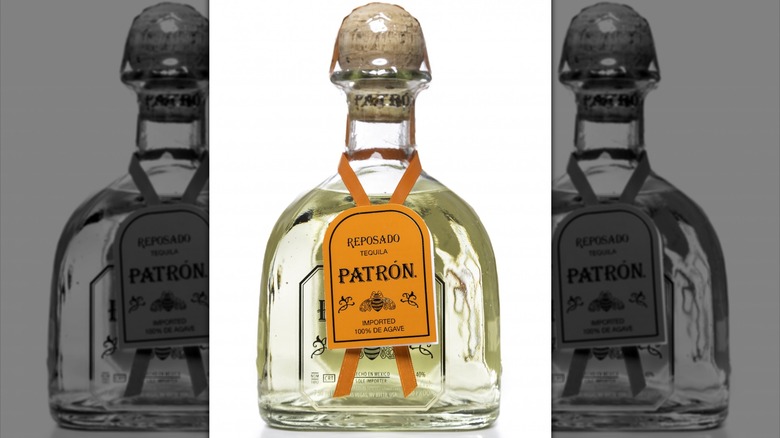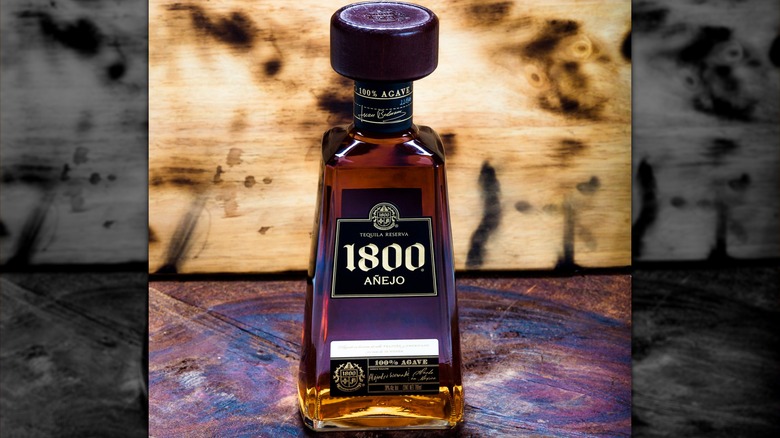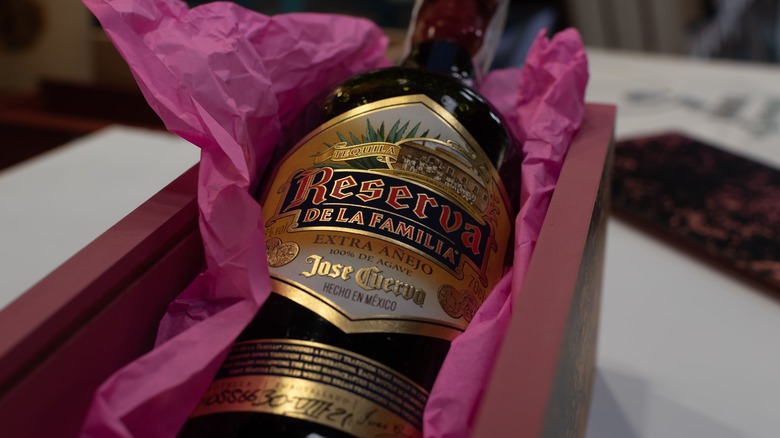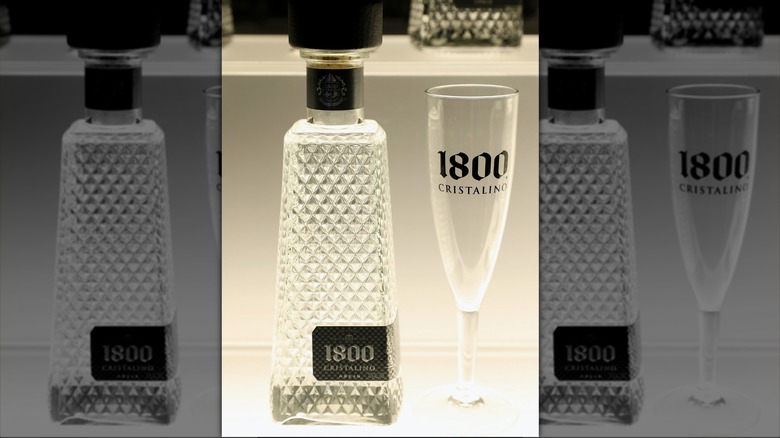6 Different Types Of Tequila, Explained
Celebrated in songs from "Tequila Sunrise" to "Straight Tequila Night," mixed into margaritas, and even used medicinally, tequila is the second best-selling spirit behind vodka. The well-revered liquor comes from Mexico via the blue Weber agave plant. While there are five Mexican regions where tequila can come from, 90% of the world's tequila comes from Jalisco in the city of Tequila. Ito be considered an official tequila it must contain a minimum of 51% blue agave. Sometimes mixtures include cane sugar, but they're usually of an inferior quality to 100% blue agave.
Between purchasing tequila for gifts, stocking a home bar, planning parties, and boosting your mixology skills, knowing the different types of tequila available will help you pick out the perfect bottle to mix into margaritas, Palomas, and Mexican mules. Whether you're only having "One Margarita" or going "Ten Rounds with José Cuervo," we've scoured the internet and endured several taste-testing sessions to bring you this collection of the six main types of tequila.
You might be wondering why mezcal isn't on our list. The two are related, but distantly. Think of it as mezcal being tequila's smoky cousin. Tequila is a type of mezcal that can only be made from the blue Weber agave plant whereas mezcal can be made from any agave plant. Tequila also doesn't contain a worm. That would be mezcal, and it's more of a marketing ploy than anything else. It's also not a worm, it's a moth larva, but we digress.
1. Blanco Tequila
The youngest member of the tequila family, blanco tequila can be aged in barrels for up to 60 days. Most of the time, though, it is bottled pretty much straight after the distilling process. Sometimes called silver or white tequila, blanco tequila is crystal clear since it isn't aged in the barrel for very long, or at all, so it doesn't retain any of the color and fragrance from the oak barrel. This is also one of the reasons that blanco is one of the least expensive tequilas.
Blanco has notes of citrus and pepper and is the most agave-tasting of the tequilas. It can be bitter on its own, but it makes a terrific choice for cocktails like margaritas and Palomas where you want that crisp taste. Mixing it with fruit juice, triple sec, and other mixers helps to tone down the strong tequila taste. To explore the flavor of blanco tequila try to include Herradura Silver Tequila, the top-selling Don Julio Blanco or Patrón Silver. For a refreshing tequila sunrise, Margaritaville Silver is an excellent choice.
2. Joven Tequila
Joven, which means "young," is usually lightly aged in a barrel. Sometimes called gold tequila, it can also be a blanco tequila that has been mixed with a reposado. This is where the difference between blanco and joven comes into play. The blanco is very clear but the joven has a slight golden color due to the additional flavors and coloring the reposado attains through the aging process.
Taste-wise, it's similar to blanco, but joven has citrus, vanilla, pear, and sometimes peppery flavors. It's usually made in small batches, which increases the price from that of other tequila varieties. Mix joven into cocktails like the classic margarita or a tequila screwdriver or sip neat or over ice. Joven is often used in recipes calling for blanco tequila as it adds a layer of depth and complexity. José Cuervo Gold Tequila, Sauza Gold, Casa Dragones Joven Tequila, and Lobos 1707 are a couple of joven selections you might want to try.
3. Reposado Tequila
Reposado means "rested" in Spanish. This type of tequila is aged in an oak or steel barrel for two months to a year. It's usually aged in oak barrels that previously held American whiskey, which gives it a subtle golden tan tone and infuses smooth flavors of oak, vanilla, and caramel.
Reposado can be used in almost any recipe that calls for a blanco tequila. It's a wonderful choice if you're looking for something in between the snappy crispness of blanco and the extra oak-y añejo. It has notes of bourbon and gin, so if you're not a fan of the Southern-inspired mint julep, you'll probably prefer to stick to a blanco tequila. Use reposado in cocktails such as a tequila Manhattan, a Hennessy margarita, a Cadillac margarita, or highballs like tequila and ginger ale. Tequila enthusiasts love reposado for shots. For your home tequila tastings, try adding a brand like Don Julio Reposado, Corralejo, or Lunazul to your list.
4. Añejo tequila
The word añejo means "old" and these tequilas are aged for at least a year, but they can be aged for up to three years. This type of tequila is aged in oak barrels, typically former American whiskey or French oak barrels, that are no more than 600 liters in size.
The añejo tequila is so full of flavor on it's own that it's often sipped neat at room temperature. If this is something you see yourself doing, just be sure to use a wide-bottomed glass with a narrow top so you experience all the robust aromas and flavors anejo has to offer.
Añejo tequila is a dark caramel color with bold and rich flavors reminiscent of other spirits aged in oak, including honey, brown sugar, butterscotch, and toasted almonds. This type of tequila is excellent as a substitute for whiskey in old fashioneds. Like a fine whiskey, añejo tequila is good for sipping neat — the smoking jacket and cigar are up to you. If you're searching for an añejo tequila try a variety like Santera Tequila, Cazul 100, or the George Clooney co-creation of Casamigos.
5. Extra Añejo Tequila
Added to the Tequila Regulatory Council (TRC) in 2006, extra añejo is one of the newest classes of tequila. Considered ultra-premium, this fine tequila offers a tasting experience likened to aged whiskey and cognac. Age is king in the tequila world and due to the time it takes to make extra añejo, it is the rarest and often the most expensive type of tequila you can buy.
Extra añejo tequila is aged for three years, sometimes longer, and may spend time in more than one barrel (no more than 600 liters in size) before it's poured into a bottle. Due to the extra aging process, extra añejo offers the strongest fragrance, flavor, and color. It's a beautiful deep gold to golden brown color and often has notes of cherry, cinnamon, or apricot. Gran Patron Piedra, Herradura Seleccion Suprema, and Suerte are a couple of extra añejo brands to try if you're interested in trying the complexities of this exclusive tequila variety.
6. Cristalino Tequila
For a clear yet rich and complex-tasting tequila, look no further than cristalino. Cristalino means "crystalline," so it tends to look like a crystal clear blanco but tastes like an aged and oaky añejo. Cristalino can be an añejo, an extra añejo, or even a reposado that has been filtered multiple times, usually with charcoal. The charcoal removes tannins, which contribute to the dry taste and deeper color of spirits. The extra distilling and aging process in American white oak barrels results in an exceptionally smooth-tasting experience.
If you feel like you've never heard of this type of tequila, you are probably correct. It was first launched in 2011 by Don Julio to celebrate 70 years of their tequila production and became the world's first clear añejo. Use cristalino in martini-inspired drinks and sweeter dessert beverages. While Don Julio 70 Cristalino may be the trendsetter, other varieties to try include comedian Kevin Hart's Gran Coramino, Rock N Roll Cristalino, Hornitos, 1800 Cristalino, and Volcan De Mi Tierra Cristalino. But, Rock N Roll does have coolest bottle.
Methodology
We've researched popular sites from around the World Wide Web, spent way too much time at local ABC stores, and used some of our amateur mixology skills (we're keeping amateur status so we can perform mixology in the Olympics). We also relied on volunteer taste testers who for some reason didn't need their arms twisted too much, to bring you this handy tequila breakdown.
